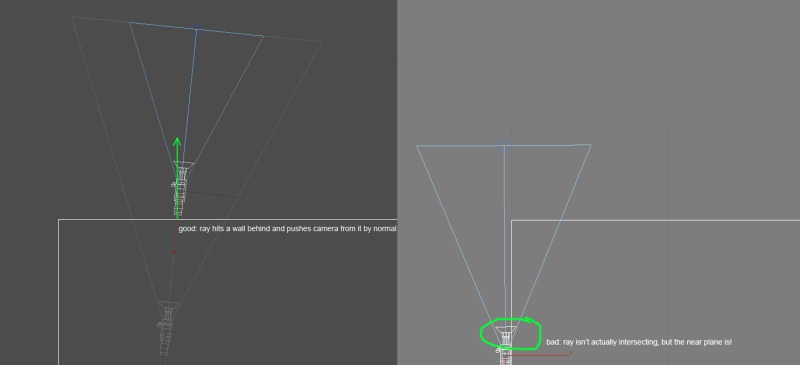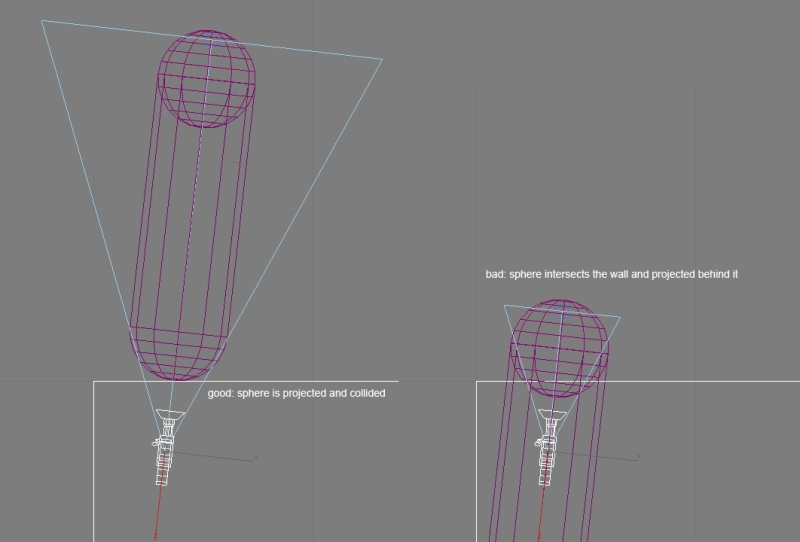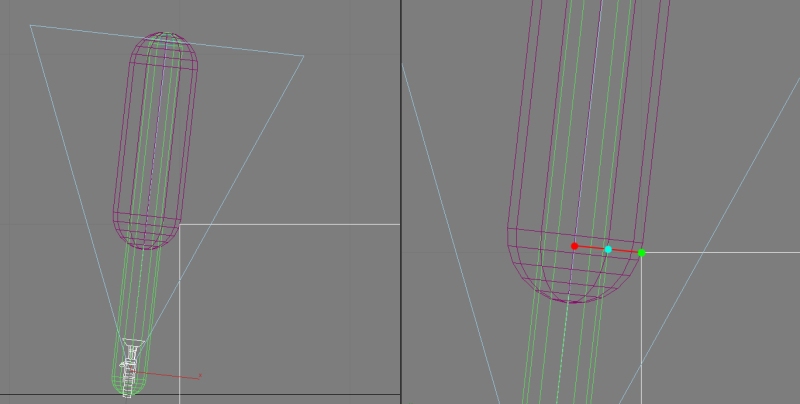Many people complained about jerky and jumpy camera behaviour in the prototype of my game, Faded. I wasn’t happy with it myself either, I just had to implement so many things with no enough time to make each one perfect. Recently I decided to finally fix it.
Third person cameras are very different in every game, from simple orbiting + collision to some attempts to make it more “cinematic”. The idea of making a “cinematic” one was also my original diploma thesis, however after a few tests I abandoned it and changed the topic of my thesis to something more familiar (real-time rendering) because I was unsure if those experiments will yield any good results, so it was just risky.
Let’s start with basic problems.
Problem 1: occlusion
95% of answers for it you’ll find up googling is “throw a ray from character to camera and position camera at picked point!“. It’s a good starting point of course, but you just can’t leave it this way, there are plenty of reasons why it’s a bad idea:
– your camera’s near plane has size, while ray has zero thickness, so you have a chance of seeing through walls;
– camera will jump from point to point abruptly.
Positioning camera to “pickedPosition + pickedNormal * radiusAroundNearPlane” is still insufficient, as can be seen here:

Luckily most physics engines support “thick” rays. If you use Unity/PhysX, use SphereCast.
There are still a few problems however:
– if spherecast already intersects a wall at its origin, it will move through it further;
– you still have abrupt jumps.
The alternative way is just to use a physical sphere and move it to the desired camera position accounting for all collisions, but the sphere can just get stuck in some concave level geometry.
To fix the first spherecast problem, you can do following:
– project the sphere to the opposite direction of the character-camera ray. So the origin of the ray is still character, by the direction is inverted;
– use picked point that is far enough as new ray origin. If nothing is picked, just use origin + invDir * farEnough;
– do SphereCast as usual, but with new origin. This way you will get rid of sphere intersecting nearby walls.
Code for Unity: http://pastebin.com/k3ti7kV2
The remaining problem is abrupt camera teleportation. How do other games deal with it? Let’s see:
Watch Dogs seems to use the simplest method – just teleporting camera at thick ray’s projected position. I can also see a quick interpolation of camera distance from close-up back to default.
L.A. Noire has more pronounced smoothed distance interpolation when the occlusion is gone. Sudden appearance of occlusion still makes abrupt movement though. The most interesting thing in L.A. Noire is the way camera follows you when you don’t move mouse. It can move around corners very intelligently. Not sure how it’s implemented, perhaps it uses AI navigation system?
Hitman Absolution tries to move camera as smoothly as possible, sliding along obstacles, before they’re in front of camera.
I think it’s a good solution, and I decided to implement it.
So here’s the idea:
Use two spherecasts. One thin (with radius to encapsulate near plane) and one thick. Then:
– project thick collision point (green point) onto ray. You’ll get red point;
– get direction from thick collision point to projected point, multiply it by thin radius and offset projected point back by it. This way you’ll get thick collision point projected onto thin capsule (cyan point);
– Get distance from cyan point to green point. Divide it by (thickRadius – thinRadius). You’ll get the [0-1] number representing how close the obstacle is to thin spherecast. Use it for lerping camera distance.
Code for Unity: http://pastebin.com/BqaJh3Vx
I think that’s quite enough for camera occlusion. You can still try to make camera even smarter at walking around corners as in Noire, but I think it’s an overkill for now. Later I’ll maybe get back to this topic.
Problem 2: composition
Now onto some “cinematic” stuff. First 3rd person games had characters mostly centered on the screen. As games evolved, overall image aesthetics started to become more important. Many photographers will agree that it’s not always the best idea to lock objects dead center – it’s just doesn’t look interesting. The basic rule you (and most importantly, computer) can apply is The Rule of Thirds. Most games today use it to simply put the character a little bit to the side.
However, can we implement a more dynamic composition search, that is not just dead locked on character being aligned to one line? And how is it supposed to look?
The best references here, in my opinion, are steadicam shots, because these are most closely related to game third-person cameras.
Take a look at some:
As you can see camera changes the focus point and distance quite dynamically, and it looks very interesting. What is not great in context of games, is that camera lags behind characters, so they see something earlier, than the camera.
Camera mainly focuses on character’s points of interest. Also what should be noted is the height of the camera, which is mostly static and not orbiting around at different heights.
Here are results of my first tests (year ago) that implemented some of the ideas:
The middle part is boring and sucks though.
The idea was to mark important objects in the level and make camera adapt to them, aligning everything by rule of thirds together. That’s what debug view can reveal:
As you can see, the “important” objects marked as green 2D boxes. These boxes are the actual input data for the algorithm. The first box always represents main character.
The algorithm itself is not ideal though and it takes designer’s time to decide which objects should be marked as important to ensure interesting camera movement. The code is a bit dirty and still work in progress, so I’m not sure about posting it here right now. However, if you find it interesting, just tell me, and I’ll post.
Here are the results so far together with smooth occlusion avoidance:




the guys from 3d buzz calculate the nearclip plane with tangent and normals, and then pick another point at the center slightly behind them… (im new to all this so i can’t help further)
Yeah, I think I’ve seen their tutorial, but decided to do it differently.
Hey, I’m interested on the code… even if it still be a bit dirty. Could you share it?
Here’s full collision code (not optimized): http://pastebin.com/Rek1uttt
Composition code is a REAL mess, and I changed it multiple times… can be hard to recover that version. Do you really need it?
Excellent explanation. I’ve been attempting to implement a quality camera system, with raycasts only, so far. The sphere cast trick makes a lot of sense.. I’m going to give it a try. Thanks for the writeup!